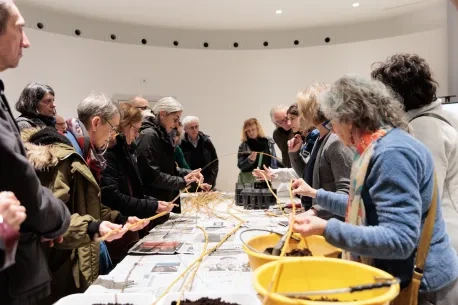INNOAIR Journal 3: Launching and scaling-up the green mobility services
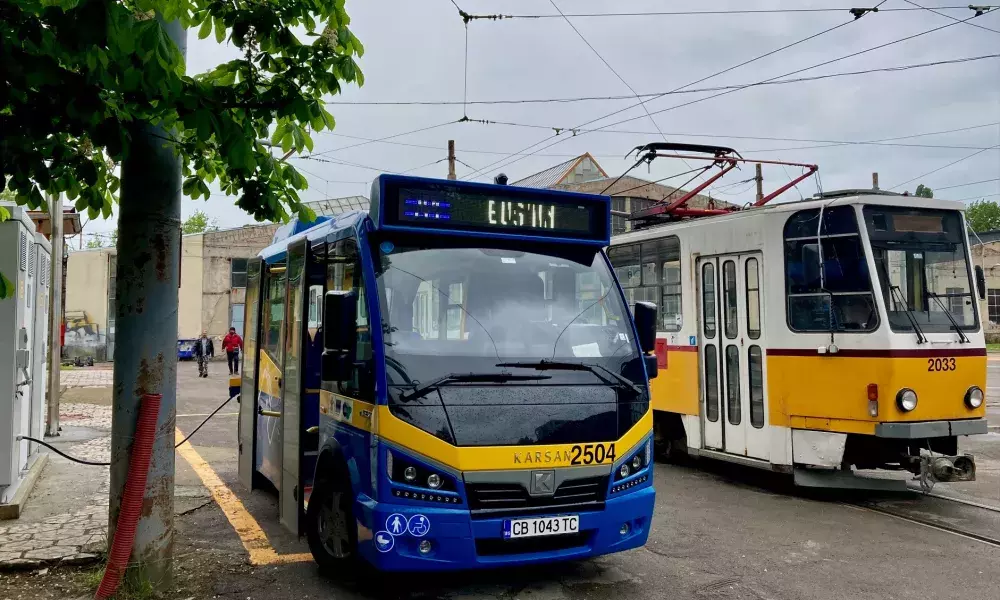
Since Summer 2020, the Municipality of Sofia, the capital of Bulgaria, has embarked on an ambitious project titled “Innovative demand responsive green public transportation for cleaner air in urban environment” (INNOAIR). Funded by the Urban Innovative Actions' (UIA) Call 5, INNOAIR's primary focus is improving air quality by effectively reducing emissions from road transport.
Previously, INNOAIR has taken significant efforts to prepare for the on-demand operation of a fleet of five electric minibuses. These buses are designed to serve as a link between suburban residential areas and the urban metro system, using an advanced software platform. This platform, at the heart of the project's innovation, leverages artificial intelligence (AI), machine learning, and big-data analytics to optimize routes and respond to user requests.
Alongside this, the project also encompasses three other innovative solutions: establishing green corridors, implementing congestion charges, and creating low emission zones. To support these initiatives, infrastructural modifications and regulatory changes have been made to encourage a shift from car usage to more environmentally friendly travel modes, such as walking and cycling.
In 2023, the project passed an important milestone with the successful launch of the on-demand electric minibus service in Manastirski Livadi, a residential area in Sofia experiencing significant and fast real estate development. The service was officially introduced to the public on May 11. The five new electric buses operate between Manastirski Livadi-East and West quarters, Pavlovo quarter, and the Buxton tram station, providing stops at major public transport hubs for seamless passenger transfers. Additionally, the service offers up to forty flexible stopping points for boarding and exiting, accessible either through the specially developed BUSINN mobile app or by signaling the driver. Electric buses even have the possibility to depart from their main route in order to provide the most convenient access points to passengers. This flexibility is illustrated in figure 1, which shows the route map with shaded areas indicating possible deviations.
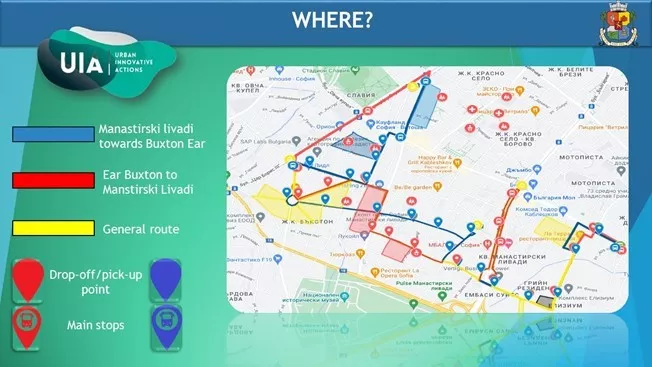
(Source: Sofia Municipality)
The BUSINN app plays a pivotal role in enhancing user experience by offering optimal pick-up and drop-off locations and providing real-time information on bus movements and estimated arrival times.
Operating every weekday from 6:30 a.m. to 10:10 p.m., the buses maintain a frequency of 16 to 18 minutes during peak hours and follow a dynamic schedule during off-peak times. In the meantime and over night, the electric mini buses are parked and charged at high power at the nearby depot of TRAMKAR, the municipal tramway operator.
The usage of the demand-responsive transport bus service is included in many regular tariffs for public urban transport in Sofia.
Notably, the service's development involved active participation from citizens. Through dedicated events, community members contributed to determining potential bus routes and points of interest, as well as expressing preferences for travel times.
An integral part of the INNOAIR project's success is the collaboration with Sofia University. The university's experts have developed methodologies to enhance the on-demand public transportation platform. This includes algorithms for route optimization and arrival time prediction, setting up the general optimization problem, data mapping for viable solutions, and models for predicting travel times between stops. A unique aspect of their approach is the use of anonymized cell phone positioning data for origin-destination calculations, a more cost-effective and frequent alternative to traditional large sample surveys. This data, comprising aggregated mobile device logs from operator networks, e.g. from voice calls, text messages or internet sessions, is instrumental in understanding public transport passenger flow dynamics.
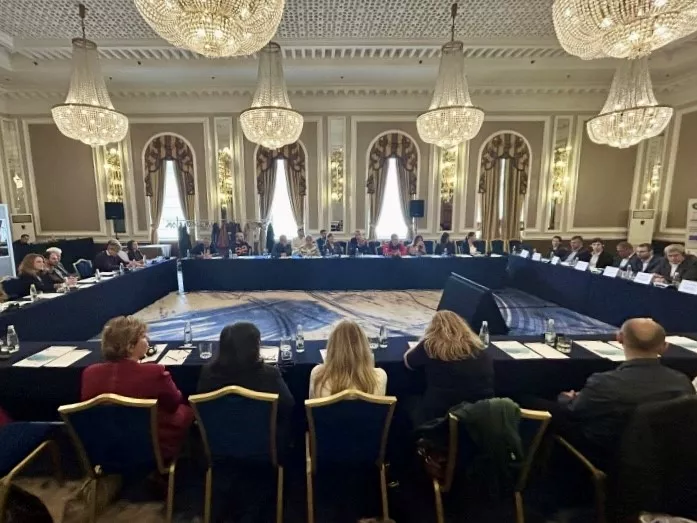
(Source: Sofia Municipality)
The Final Conference of the INNOAIR project, held on May 18th in Sofia, reviewed the project's achievements and outlined future directions for urban mobility and green transition in the city. The event was opened by Doncho Barbalov, Deputy Mayor of Sofia Municipality and Head of INNOAIR, alongside Silvia Georgieva, Executive Director of the National Association of Municipalities in the Republic of Bulgaria. They emphasized the importance of innovative projects for urban development and the necessity of citizen support and non-standard decision-making.
Key speakers of the first session, focused on the four innovative solutions developed by INNOAIR, and moderated by UIA expert Gereon Meyer, included Ivan Nikolov, Director of the Transport Directorate at Sofia Municipality, who discussed the success of the on-demand public transport in Sofia's southern neighborhoods and the introduction of the congestion charge. Dimitar Petrov, Director of the Traffic Management and Analysis Directorate, spoke about the structuring of low-emission zones. Additionally, Metodi Avramov from the Urban Mobility Center presented the rationale behind the green corridors.
The second panel, moderated by Sevdalina Voynova from the Sofia Development Association, focused on the community-centric approach of the INNOAIR project. Participants included Radoslav Rizov from Sofia University, Prof. Dr. Stanimir Kabaivanov from Plovdiv University, Prof. Dr. Dimitar Atanasov from the National Institute of Hydrology and Meteorology, and Svetlana Lomeva, Executive Director of Sofia Development Association. Lomeva highlighted the importance of community feedback, citing gratitude received from residents in Manastirski Livadi as a testament to the project's success.
To optimize the wider spread and potential transfer of its innovative solutions, the INNOAIR project under the guidance by the National Association of Municipalities in the Republic of Bulgaria, organized a series of dissemination events between March and June 2023. These included four webinars and an in-person workshop, coinciding with the project's final conference. These sessions were instrumental in raising interest in mainstreaming the innovations and fostering their adoption in other cities. The events attracted significant attention, drawing in 400 attendees from over 70 local and regional authorities, both from Bulgaria and internationally. A notable trend was the heightened interest from cities with larger populations and more advanced public transport systems. However, the potential application of on-demand transport for commuting in smaller settlements or for connecting municipal centers with surrounding villages also raised notable attention. One of the key challenges identified by participants was the need for adjustments in legal and regulatory frameworks to implement certain solutions. Also, the project's soft measures were also highly valued, underscoring their crucial role in the project's overall success.
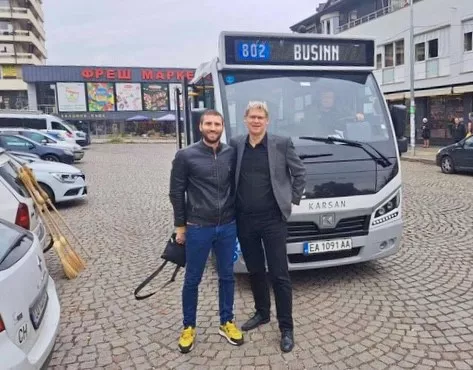
(Source: Sofia Municipality)
After the completion of the INNOAIR project, the on-demand e-minibuses public transport not only continues in Manastirski livadi area but the model has been scaled up in three other Sofia neighbourhoods, i.e. Malinova Dolina, Vitosha and Gorna Banya.
The progress of the INNOAIR project activities has been consistently evaluated in relation to the seven implementation challenges of Urban Innovative Actions (UIA) projects, identifying several key insights. The summary below outlines the relevance of these challenges in terms of their significance, intensity, probability, and timing across various phases of the project timeline covered in this journal.
2.1 Leadership
While the INNOAIR project is coordinated by the Municipality of Sofia, represented by the Mayor, the day-to-day leadership role is pursued by Ivan Nikolov, the city’s Director for Transport, with support by Sevdalina Voynova, Programme Director at the Sofia Development Association. In January 2023, a change in the project coordination occurred, when Kristian Krastev, the previous deputy mayor of Sofia in charge of transportation stepped down from this role to take on a new role as chairman of the board of the National Railway Infrastructure Organization. Thereafter the coordination of INNOAIR was transferred to Doncho Barbalov, the deputy mayor of finance and healthcare who is also the acting deputy mayor for transportation. This change showed no major impact on the project quality as the new coordinator ensured the continuous commitment of the Municipality of Sofia to the INNOAIR project. He also spoke at the Final Conference of the project in May. Yet another change occurred with the change of city government after the mayoral elections in November 2023, however it did not affect the INNOAIR project activities as those had been concluded before.
2.2 Public Procurement
The five electric mini buses that the City of Sofia had purchased with the support by the INNOAIR project in 2022 were finally put into the on-demand service in the Manastirski Livadi neighborhood of Sofia in 2023, and have been operating since then. They are parked and charged overnight in a nearby Municipal tram depot.
2.3 Participation
The active engagement of citizens in the development process of the INNOAIR project continued in the beginning of 2023 through the organization of an additional citizen challenge aimed at various groups, including cyclists, local residents, car owners, and schools. These challenges sought to foster collaboration between stakeholders and creative professionals like visual artists, designers, and communication experts to produce communication materials for the project. This approach was rooted in the understanding that citizen participation is crucial for the success of urban initiatives, especially those that require behavioral changes, such as the adoption of public and active transport methods and the acceptance of low emission zones. By involving citizens in the co-design and co-ownership processes, INNOAIR aimed to enhance the relationship between the city and its inhabitants, ensuring their active involvement in community development and increasing the likelihood of project success through shared ownership and acceptance.
2.4 Cross-Department Working
Successful implementation of the four innovations of the INNOAIR project is a major collaborative effort involving public and private partners, researchers, transport operators, and technology vendors. The required partnerships go far beyond the project consortium developing the innovations to unlock capacities of multiple departments as infrastructures need to be built, protocols to be updated and legal gaps need to be found and normative framework need to be amended both at local and at national level. Examples of such issues in 2023 included to creation of charging infrastructure for the minibuses and the updating of the Ordinance on the order and conditions for usage of public transport in the territory of Sofia Municipality to introduce the on-demand service and the related tariff structure. According to the consortium of the INNOAIR project, it is essential that the involved departments have the necessary technical capacities and competences. At the same time, such collaborations always face challenges and occasional delays due to the different business models or role definitions of individual partners, IPR and open-source issues, lengthy processes for partnership terms as well as continuity and sustainability models.
2.5 Monitoring
In 2023, the INNOAIR project published its Final Monitoring and Evaluation Report measuring the success against established goals and objectives and the applicability and transferability of the piloted solutions:
https://innoair-sofia.eu/images/documents/documents-bg/D2_5_2_M_E_Report_pub.pdf.
The main focus of this evaluation is to assess the project's success in achieving its expected benefits, gather stakeholder feedback on the effectiveness of its innovations, examine the impact of service changes on operations, and evaluate the project's overall impact on service activity and performance. Particularly, the report contains an assessment of 26 quantifiable Key Performance Indicators (KPI) regarding zero emission transportation, reduction of traffic, behavioral change towards a green and more sustainable way of travel, customer/client satisfaction as well as financial sustainability. Overall, it can e.g. be stated that the on-demand public transport service with the electric minibuses contributed quite successfully to the reduction the emissions of particulate matter, NO2 and CO2 by achieving the respective targets in the 80 to 90 percent range. Moreover, the acceptance and adoption of the different innovations by citizens turned out to meet the expectations, and sometimes even exceeds those, particularly for the on-demand service and the green corridors. The impact of the low-emission zones on emissions, however, remained below expectations, while the impacts of congestion charging were not rated. Interestingly, the expected cost of the on-demand service turned out to be far lower than those of the regular public bus services, namely just 30 percent.
2.6 Communication
The launch of the on-demand bus service was a matter of intense communication activities of the INNOAIR project, aimed at creating public awareness of the service, its area of operation and the way to order it. Already prior to the launch, two information days were held for citizens of the Manastirski livadi district in February 2023. During those days, representatives of Sofia Municipality presented the service, explained it, and discussed with citizen’s interest groups. The attendees were also able to get acquainted with the BUSINN mobile app, through which they are able to order a minibus to pick them up, see the movement of the minibuses in real time and check for a nearby drop-off or pick-up point. On May 11, 2023, the on-demand transport service was officially presented to the public. City official emphasized that the inclusion of an on-demand option in the traditional public transport services of passengers would be an important part of Sofia’s overall policy for modernization of urban transport. They also thanked the citizens of Manastirski Livadi for their active participation in the creation and testing of the service so that it best meets the needs of the residents of the neighborhood.
2.7 Scaling-Up
To enhance the impact of its achievements, the INNOAIR project employed several strategies. Initially, it collaborated with the National Association of Municipalities in the Republic of Bulgaria, organizing multiple seminars aimed at transferring knowledge. For instance, during the project's final conference, one such seminar was conducted in-person. These events featured project partners as the main speakers, who showcased outcomes in key areas: green public on-demand transport, congestion charge models, low emission zones, and green corridors for active transportation. They also shared their experiences and offered advice to their peers from other local and regional governments on the benefits and obstacles of adopting these innovative solutions. A notable challenge highlighted was the need for changes in the legal and regulatory framework to facilitate the implementation of certain solutions. Additionally, the project's 'soft measures' were praised for their significant contribution to its overall success. Following the project's conclusion, the scaling-up efforts continued, notably with the expansion of the INNOAIR on-demand e-minibuses public transport service. Initially launched in the Manastirski Livadi area, this service was extended to three additional neighborhoods in Sofia: Malinova Dolina, Vitosha, and Gorna Banya, four months after the project ended.
In 2023, the INNOAIR project focused on launching the innovative on-demand electric minibus service in Manastirski Livadi, being the most significant one out of the project’s actions towards improving Sofia's urban mobility and air quality. This service, featuring flexible routes and stops accessible via a mobile app, directly addresses the need for efficient and environmentally friendly transportation options. Beyond this, the project organized a final conference, highlighting its achievements and setting future directions for urban mobility and green transition in Sofia. The conference served as a platform for sharing insights on the successful implementation of the project's innovative solutions, including green corridors, congestion charges, and low emission zones, and engaged a wide audience, including other municipalities, in discussions on scalability and adoption of these solutions in other places.
In 2023, the INNOAIR project successfully navigated all typical hurdles associated with UIA projects. Due to its professional management and high level of maturity potential challenges turned into opportunities, enhancing the project's implementation and impact.
Reflecting on the activities of 2023, it is evident that the INNOAIR project has made significant progress in transforming public transport in Sofia. By successfully launching the on-demand electric minibus service, the project not only improved urban mobility and contributed to better air quality, but it also succeeded in implementing a solution that was co-designed with the citizens. This comprehensive engagement with the community, the integration of advanced technologies for service optimization, and the proactive dissemination of its achievements underscore INNOAIR's role as a pioneering initiative. These efforts, combined with the project's ability to scale and adapt, highlight its success in setting a new standard for urban transportation solutions, potentially serving as a blueprint for cities in Bulgaria and the EU aiming for greener, more efficient, and demand-responsive public transport systems.
About this resource
The Urban Innovative Actions (UIA) is a European Union initiative that provided funding to urban areas across Europe to test new and unproven solutions to urban challenges. The initiative had a total ERDF budget of €372 million for 2014-2020.
Similar content
